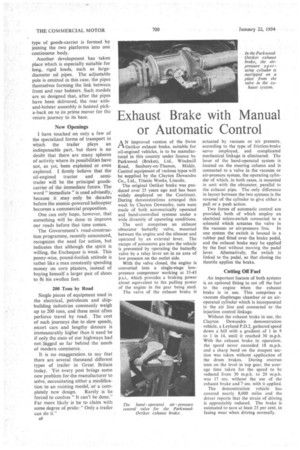Exhaust Brake with Manual or Automatic Control
Page 42

If you've noticed an error in this article please click here to report it so we can fix it.
AN improved version of the Swiss Oetiker exhaust brake, suitable for oil-engined vehicles, is to be manufactured in this country under licence by Parkwood (Brakes), Ltd., Windmill Road, Sunbury-on-Thames, Middx. Control equipment of various types will be supplied by the Clayton Dewandre Co., Ltd., Titanic Works, Lincoln.
The original Oetiker brake was produced over 25 years ago and has been widely employed on the Continent. During demonstrations arranged this week by Clayton Dewandre, tests were made of both automatically operated and hand-controlled systems under a wide diversity of operating conditions.
The unit comprises an exhaust obturator butterfly valve, mounted between the engine and the silencer and operated by an external lever. The escape of poisonous gas into the vehicle is prevented by operating the butterfly valve by a relay lever set in an area of low pressure on the outlet side.
With the valve closed, the engine is converted into a single-stage lowpressure compressor working at 35-45 p.s.i., which provides a braking power about equivalent to the pulling power of the engine in the gear being used.
The valve of the exhaust brake is
actuated by vacuum or air pressure, according to the type of friction-brake servo employed, and complicated mechanical linkage is eliminated. The lever of the hand-operated system is located on the steering column and is connected to a valve in the vacuum or air-pressure system, the operating cylinder of which, in both cases, is mounted in unit with the obturator, parallel to the exhaust pipe. The only difference in layout between the two systems is the reversal of the cylinder to give either a pull or a push action.
Two forms of automatic control are provided, both of which employ. an electrical micro-switch connected to a solenoid which actuates the valve in the vacuum or air-pressure line, In one system the switch is housed in a rubber pad fitted over the brake pedal, and the exhaust brake may be applied by the foot without moving the pedal lever. Alternatively, the switch is linked to the pedal, so that closing the throttle applies the brake.
Cutting Off Fuel
An important feature of both systems is an optional fitting to cut off the fuel to the engine when the exhaust brake is in use. This comprises a vacuum diaphragm chamber or an airoperated cylinder which is incorporated in the air line and connected to the injection control linkage.
Without the exhaust brake in use, the Clayton Dewandre demonstration vehicle, a Leyland P.D.2, gathered speed down a hill with a gradient of 1 in 9 to 1 in 14, until it reached 30 m.p.h. With the exhaust brake in operation, the speed never exceeded 18 m.p.h. and a sharp bend on the steepest section was taken without application of the drum brakes. During overrun tests on the level in top gear, the average time taken for the speed to be reduced from 30 m.p.h. to 20 m.p.h. was 17 sec. without the use of the exhaust brake and 7 sec. with it applied.
The demonstration vehicle has covered nearly 8,000 miles and the driver reports that the strain of driving is appreciably reduced, The brake is estimated to save at least 25 per cent. in facing wear when driving normally.




























































































